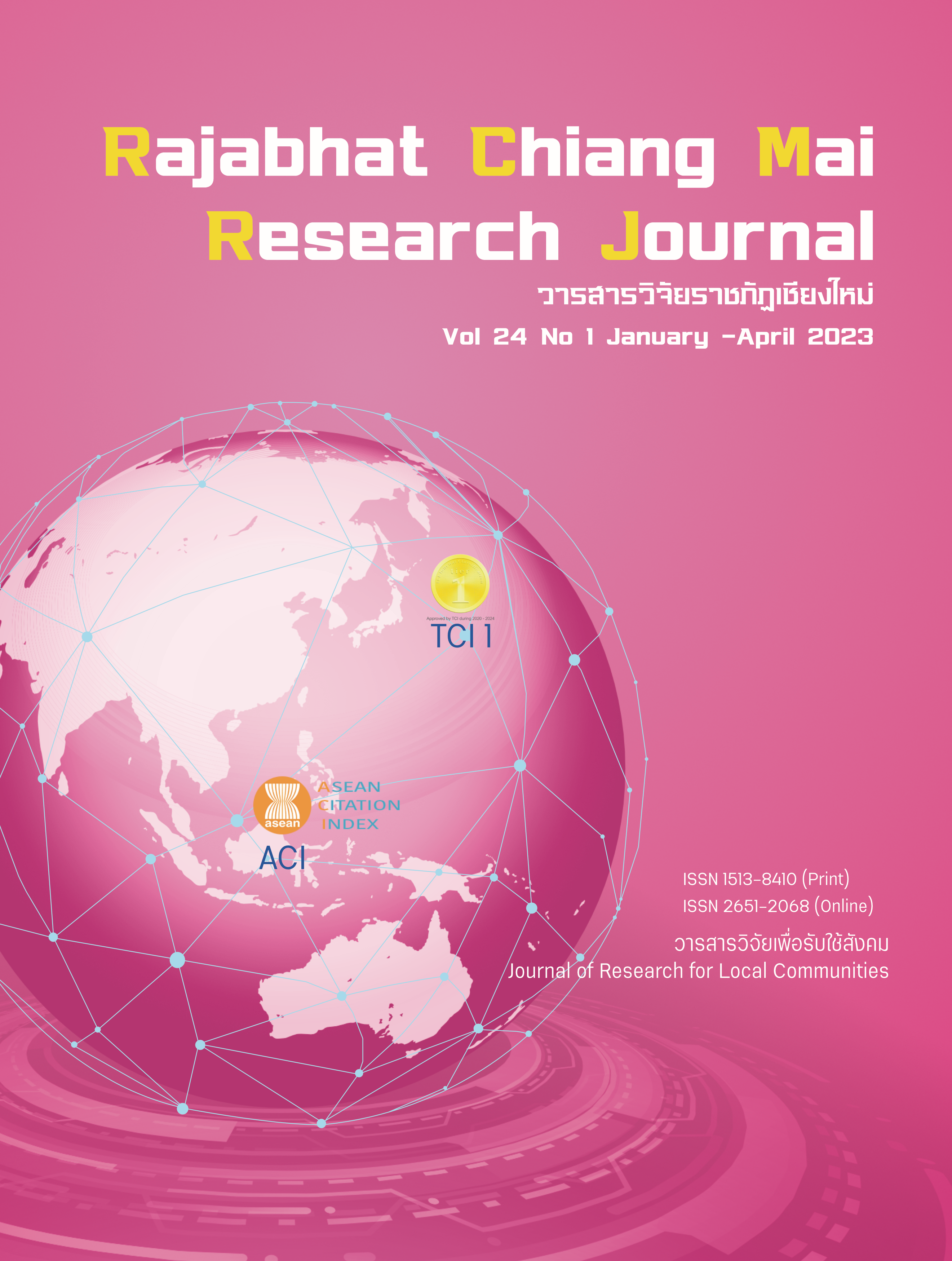Customer Preferences for Coworking Spaces in Chiang Mai
DOI:
https://doi.org/10.57260/rcmrj.2023.263045Keywords:
Coworking space, Chiang Mai, Preference, Service marketing mixAbstract
The objective of this research is to study the customer preferences for coworking spaces in Chiang Mai Province as well as to make a comparison among customers of different occupations. This research applies quantitative research methodology and uses an online questionnaire for data collection. The researcher then applied purposive sampling by collecting data only from those who had used coworking space services during May 1, 2021 – August 16, 2021. The data collection was taken place in August – November, 2021. The sample includes 385 coworking spaces customers. The researcher applied descriptive statistics including frequency, mean, and standard deviation to analyze data and also applied Analysis of Variance to analyze the difference among various informant groups. The study showed that most of the respondents were female, aged 21 -25 years, hold a bachelor's degree, and earned average monthly income between 10,000-20,000 baht, had used the coworking service within the past 6 months, visit coworking space around 1 – 5 times per month, spent about 1 – 3 hours per each visit, and usually visit during 9:01 – 12:00 hours. The customer preferences toward service marketing mix of coworking spaces in Chiang Mai are product, place or channel, price, process, physical evidence, promotion, and people, all at the highest level. In comparison of customer preferences among different occupation, it was found that there are 3 factors that showed the statistically significant difference which include price, promotion, and people. As the result revealed that generation Z are the main customers of coworking spaces, the business owners shall focus on applying suitable marketing mix strategies to meet their preferences.
Downloads
References
Appel-Meulenbroek, R., Weijs-Perrée, M., Orel, M., Gauger, F., & Pfnür, A. (2021). User preferences for coworking spaces; a comparison between the Netherlands, Germany and the Czech Republic. Review of Managerial Science, 15, 2025–2048 https://doi.org/10.1007/s11846-020-00414-z
Color Business Center. (2022). How many of you use a coworking space? Retrieved from https://coworkers.lu/en/how-many-of-you-use-a-coworking-space/
Coworkingspace. (2022). Find coworking space in Chiang Mai. Retrieved from https://www.coworker.com/thailand/chiang-mai
Dan. (2022). What is a coworking space? Retrieved from https://www.halfhalftravel.com/remote-work/what-is-a-coworking-space.html
Deskmag. (2017). The Members: How, When & Why Do They Work in Coworking Spaces? Retrieved from https://www.deskmag.com/en/coworkers/coworking-space-members-how-when-why-are-people-working-in-coworking-spaces-statistics-market-report?limitstart=1
Katharangsiporn, K. (2018). Expanding space for co-working. Bangkok Post. Retrieved from https://www.bangkokpost.com/business/1474061/expanding-space-for-co-working
McCarthy, E. J. (1960). Basic marketing, a managerial approach. Homewood: R.D. Irwin.
Moreno, H. (2022). Key Coworking Space Audiences to Target. Retrieved from https://www.andcards.com/blog/member-experience/coworking-audiences-types/#1-corporate-customers
Professional Academy. (2022). Marketing Theories – The Marketing Mix – From 4 Ps to 7 Ps. Retrieved from https://www.professionalacademy.com/blogs/marketing-theories-the marketing-mix from-4-ps-to-7-ps/
Rovinelli, R. J., & Hambleton, R. K. (1977). On the use of content specialists in the assessment of criterion-referenced test item validity. Dutch Journal of Educational Research, 2(2), 49-60. https://psycnet.apa.org/record/1979-12368-001
Statista. (2022a). Frequency of coworking space usage worldwide in 2016 and 2017. Retrieved from https://www.statista.com/statistics/797652/frequency-of-coworking-space-usage-worldwide/
Statista. (2022b). Number of coworking spaces worldwide from 2018 to 2020 with a forecast to 2024. Retrieved from https://www.statista.com/statistics/554273/number-of-coworking-spaces-worldwide/
The Workplace Co. (2021). What is a coworking space? Retrieved from https://www.theworkplacecompany.co.uk/what-is-a-coworking-space.html
Tirakanant, S. (2012). Research Methodology in Social Sciences: A Guide to Practice. Bangkok: Chulalongkorn University. (In Thai)
True, B. (2022). Who Uses Coworking Spaces, and Why Are They Beneficial? Retrieved from https://www.thecannon.com/blog/who-uses-coworking-spaces-and-why-are-they-beneficial
Uakarn, C., Chaokromthong, K., & Sintao, N. (2021). Sample Size Estimation using Yamane and Cochran and Krejcie and Morgan and Green Formulas and Cohen Statistical Power Analysis by G*Power and Comparisons. Apheit International Journal, 10(2), 76 – 88. https://so04.tci-thaijo.org/index.php/ATI/article/view/254253
Wikivoyage. (2022). Chiang Mai. Retrieved from https://en.wikivoyage.org/wiki/Chiang_Mai
Williams, W. (2022). What are Concepts and Assumptions of Consumer Preference? Retrieved from https://study.com/learn/lesson/consumer-preference-concept-assumptions.html
Downloads
Published
How to Cite
Issue
Section
License
Copyright (c) 2023 Rajabhat Chiang Mai Research Journal

This work is licensed under a Creative Commons Attribution-NonCommercial-NoDerivatives 4.0 International License.
1. Articles, information, content, images, etc published in the “Community and Social Development Journal” are copyrighted by the Community and Social Development Journal, Chiang Mai Rajabhat University. In order to properly distribute the articles through print and electronic media, the authors still hold the copyright for the published articles under the Creative Commons Attribution (CC BY) license, which allows the re-distribution of the articles in other sources. References must be made to the articles in the journal. The authors are responsible for requesting permission to reproduce copyrighted content from other sources.
2. The content of the articles appearing in the journal is the direct responsibility of the article authors. The editorial board of the journal does not necessarily agree with or share any responsibility.














